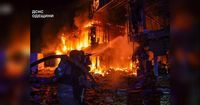On the evening of March 20, 2025, a wave of drone attacks launched by Russian forces targeted Odesa, a major city on the Black Sea. The attacks marked a significant escalation in hostilities as they came alongside a series of bombings in Zaporizhzhia Oblast, affecting both civilian infrastructure and residences.
The drone assault on Odesa saw multiple drones approach in waves, aiming to overwhelm local air defense systems, as noted by Andriy Kovalенко, head of the Center for Countering Disinformation. Local sources reported explosions across the city, leading to widespread fires.
The damage was immediate and severe. Buildings were hit, including a shopping center and various shops, and at least one multi-story residential building was reported to be damaged. Firefighters battled flames engulfing multiple sites in Odesa, prompting a significant response from emergency services. More than 70 rescuers, equipped with 22 fire trucks, tackled the situation alongside five volunteers and additional equipment, as confirmed by local emergency services.
In the aftermath of the attack, three adolescents were confirmed injured. The emergency services acted quickly to provide assistance, treating the victims immediately. John Doe, spokesperson for the emergency service team, stated, “Three young individuals suffered injuries during the chaos, but our teams were able to respond effectively.”
Simultaneously, Russian forces also targeted Zaporizhzhia Oblast, launching aerial bombs that resulted in five reported injuries, including a 61-year-old man, three women aged 50 to 55, and a child. Local authorities confirmed that aid was promptly administered to all injured parties. Ivan Fedorov, head of the Zaporizhzhia Regional State Administration, reported that two homes were completely destroyed and three others sustained significant damage. He noted the urgency of repairs, saying, “We must act swiftly to restore safety to affected families.”
The situation remained tense as emergency crews worked through the night to manage the consequences of the onslaught in both regions. In addition to residential buildings being damaged, local infrastructure suffered severely, with reports of localized power outages affecting areas such as Primorsky, Peresyp, and Kyiv districts of Odesa.
As emergency responders in Odesa worked hard to mitigate the damage, they were also called to action in other regions. Reports emerged of airborne bombing strikes leading to injuries in the Sumy district where, according to some residents, three distinct strikes were noted, although reports of injuries in this area remained unconfirmed.
This barrage of attacks isn't an isolated event; it underscores a recent change in tactics by Russian forces, indicating they are now focusing on larger groups of drones to apply overwhelming pressure on air defense systems. This tactical shift raises concerns among defense analysts regarding the effectiveness of Ukraine’s current air defense capabilities.
The Russian strikes have intensified since earlier this month, with Odesa previously enduring similar drone attacks on March 8, 11, and 17. Each of these attacks has contributed to escalating fears surrounding civilian safety and infrastructure security in the region.
As noted, the effects of the most recent wave have been devastating, with the potential for long-lasting damage to civilian lives and property. The ongoing conflict showcases the dire humanitarian situation faced by residents dealing with the relentless threat of aerial bombardment.
This cycle of violence represents a grim reality in the ongoing conflict between Russia and Ukraine, highlighting the risks posed not only to military personnel but to civilians as well. The need for international attention and action is more critical than ever, underscoring the resilience and vulnerability of those living in these troubled areas.
As the day unfolded, the streets of Odesa began to see the direct consequences of the ordeal; residents found themselves cleaning up debris and trying to salvage what remains of both their properties and their lives amid a backdrop of destruction.
Calls for assistance have emerged from local officials as they seek international support to address the humanitarian impact of these attacks. Officials emphasize that a strategic response is necessary to help protect civilians and restore infrastructure in communities affected by ongoing hostilities.
In summary, the recent wave of drone attacks on Odesa and surrounding regions tells a story of increasing danger for civilians caught in the crossfire. As communities begin to recover, the international community’s response remains a critical factor in determining their resilience and ability to rebuild.





